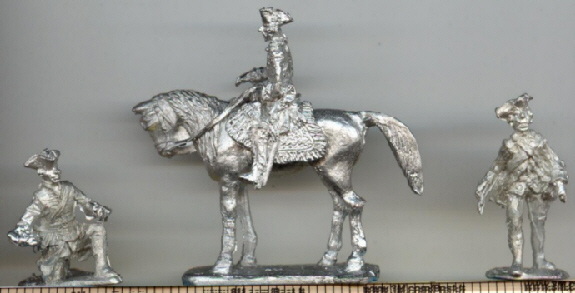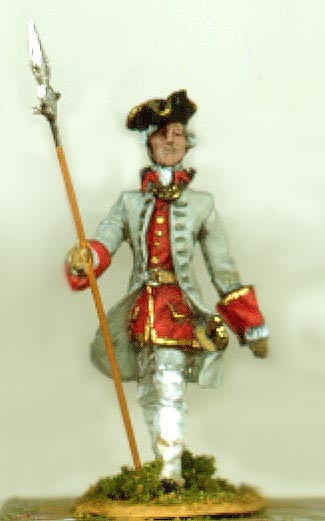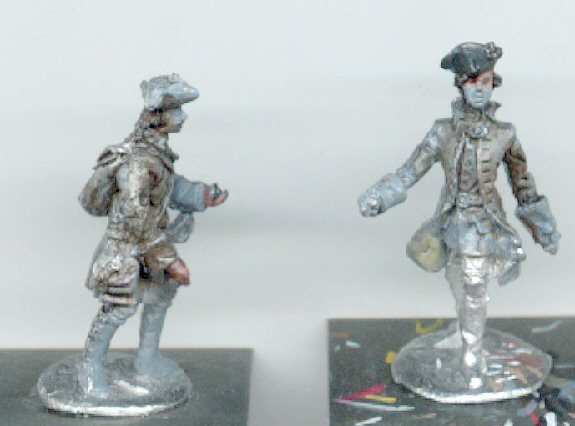|
|
|||||||||||||||||
 |
|||||||||||||||||
 |
|||||
|
Originally Published on the Spanner and the Yank Web Site. Used by permission. |
|||||
|
February 13, 2002 (Also see Mike's review of the Stadden "Tradition" line. Dal.) There recently was an interesting discussion in Yahoo’s 18th Century “Lace Wars” forum. Some of the older hands reminisced about the quality of 30 mm “Willie” figures, sculpted by Edward Suren. If I have my facts straight, the miniatures were released in the early ‘70’s. One posting indicated the once popular figures are still available through a U.S. distributor, Tradition USA (info. below). While their ranges (F&I, American Revolution, Napoleonic, etc.) are not sufficient in scope to be considered wargaming lines by today’s standards, they certainly served as such years back. Figure converters will be able to produce a decent range of poses. I sent away for some French & Indian Wars figures. These pewter castings set a new record as the most expensive samples procured for a “Spanner & Yank” review! With the $4.00 minimum postal charge, four foot and one mounted figure set me back close to $20. (You’d have thought they’d give me a break on SAMPLES.) The foot figures are priced at $2.25, the mounted ones, $4.75. While there is a small catalog you can purchase, it’s not very helpful. You’re pretty much ordering blind. The figures arrived and the initial impression was one of delight. Anatomically correct figures! On inspection, however, they were not well cast (there were holes that needed filling, plenty of flash, and a couple of broken weapons). The sculpting varied from having limited detail to being no more than out-and-out sludge (Prussian musketeer at right in the picture below).
Interpreting the moving human anatomy and, in particular, imparting the feeling of a period (i.e., it’s apparent Edward Suren was gifted as both those neck stocks served a purpose). The miniatures possess nice balance. The “true” anatomy makes them appear smaller. The bad news is that Suren (probably because it was not a requirement at the time) didn’t spend a lot of effort in replicating uniform detail and straitening unclean lines. By today’s standards, the biggest negative is that the faces are rudimentary. No eyes, just an indented area. It’s obvious the focus was on how the figures would like at a distance vs. under a magnifier. I could pick apart the sculpting, but I’d prefer addressing a larger topic. When I put these anatomically pleasing, yet marginal Willie’s along side either Foundry and Front Rank SYW figures, the argument Dal and I have made for for years continues to rang true. At a distance of two feet, they are superior figures to the gnome-like designs in vogue over recent years. I remain baffled at why the historical hobbyists veered away from anatomically correct castings ( aside from the concern over fragility ). I do know that, in an A-B comparison on aesthetic merits, the choice is an easy one for myself. [DFHM Editor’s Note: this image is missing.] Who’d Wargame With Willie’s? ‘Only people who love a challenge and are obsessed with the visual aspect of gaming need apply.’ It requires a good deal of work to obtain decent results from these castings. You must (1) be skilled at using milliput, or the like, to repair broken weapons, fill in casting shortcomings, and build up areas (note the arms in the French infantryman above were thickened). (2) You must be good at reading detail that’s not well defined. (3) Ideally, you should have some skill at converting and/or sculpting figures. (4) Lastly, you’ll need deep pockets to contemplate building a brigade in what I’d recommend -- a 1:20 figure ratio. There’s no point in jumping through these hoops, making things look as lifelike as possible, only to defeat the purpose with three fig companies. Fortunately, I was in the mood for the challenge and rebuilt the broken staff and saber, crafted an eye for the French officer below, and started constructing ones for Frederick’s horse. The Horse The scan above pretty much tells the story. It’s nice to find a line where a horse is at least 14 hands high. But this one would require a step ladder to reach the stirrup! If this sample is any indication, Suren struggled with horses. Aside from proportional issues, the figure has a flat-like feeling, i.e., the width being poorly defined. Ed Studer, of Tradition USA,, suggested incorporating Tradition 30 mm mounted figures with the Suren infantry. While this range is even smaller (albeit less expensive), he suggested the two were compatible. And there are some SYW options. I can’t confirm they mix well, however.
Summation Willie’s (in their present incarnation) are expensive, come up short on casting quality, and lack decent detail. The flip side of the coin is they have the key ingredient for creating an impressive looking display on the tabletop. The correctly proportioned anatomies allow the hobbyist to move closer to “realistic” looking units. In the best of worlds, it would be wonderful if a talented sculptor, or manufacturer, purchased and reworked this potentially excellent range. The hard lifting has already been done. The armatures have been created. They need some detail, refinement, and additions. I’m not going to rate these as they’re not really wargaming figures at this point. However, I wished to call them to everyone’s attention. If you have plenty of patience, very nice results can be achieved. The real effort is in producing a decent looking figure prior to painting. The painting itself is easy as the surface areas are comparatively small to those of Foundry and Front Rank. Some people think the latter are easy to paint. That’s true if you’re doing a paint-by-the-number, one color job. But I find them just the opposite, as much effort is expended in trying to make them look non-dwarfish. Shadows here, there, and everywhere
Willie’s are an interesting option! Good Gaming, Mike Contact: Ed & Miriam Studer A few words about the beginnings of this range from Deryk Coleman: I knew Ted Suren back in the sixties when we both used to wargame with Peter Young....Many of the figures he produced resulted from wargames we used to play against both Peter and Charles Grant. (Deryk, you're lucky to have played with these fine gents. Dal.) Ted had a shop in Sloane Square complete with an iron spiral staircase that led down into the workshop. All originals were produced in plasticine. Foot sold at two shillings (10p) Mounted at three shillings.(15p) Tradition Figures sculpted by Charles Stadden were about the same price. Surens had both finer detail and the mix was fine grade tin with 4% antimony added. Tradition figures contained a high lead mix-which made them more malleable. I recognize the figures you show but they appear extremely rough compared to the items that flowed from Sloane Square. Ted also produced figures for other era's. ECW- prodded by Peter Young (who finally got fed up with table top stuff and started the "Sealed Knot") and items from the Norman Conquest. I suppose I collected -and painted - some 2,000 figures most of which are now with my son in Germany. I have a couple of hundred that I didn't get around to finishing and also a large number of 25 mm Garrison Figures (also no longer produced) which were too early to suffer from the influence of Fantasy items and thus have some anatomical accuracy. Minded to take up the cudgels again I was astonished to find Munchkins now fighting table top wars. The view that these thick bodied bumpkins are more representative of the period is possibly permitted eccentricity. Ted will be revolving in his catacomb no doubt. |
|||||
 |
|||
|
|
|||


